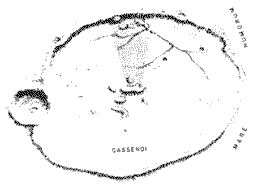 |
Science Frontiers ONLINE No. 99: May-Jun 1995 |
|
|
Ltps And Ets
Looking through our telescope for lighter fare, we discover a recent issue of Selenology. In it, A.V. Arkhipov, a member of the Research Institute on Anomalous Phenomena, based in Ukraine, presents a paper headed by the following abstract:
"The "invasions" of Earth's vehicles in certain lunar regions stimulate a statistically significant, real, temporary increase in the probability of lunar transient phenomena there. It could be used as an indicator of a hidden alien presence on the moon also."
 A transient, reddish glow (shaded area) seen in the crater Gassendi on April 30 - May 1, 1966. Alien activity? |
(Arkhipov, Alexey V.; "'Invasion Effect' on the Moon," Selenology, 13:9, no. 1, 1994) We have never examined this journal.
Comment. Reigning paradigms make the moon a barren, lifeless place. But readers of SF should be aware that the popular literature puts forth assertions that the astronauts found more than rocks on the moon, and that NASA is covering up these discoveries. Some see artificial constructions in close-up photos of the lunar surface. There are even entire books devoted to an "alien presence" on the moon! Mainstream selenologists attribute the thousands of recorded LTPs -- all legitimate scientific phenomena -- to gas releases, meteor impacts, etc., but certainly not ETs. Nevertheless, Arkhipov's correlation of LTPs and spacecraft activity should be checked out.